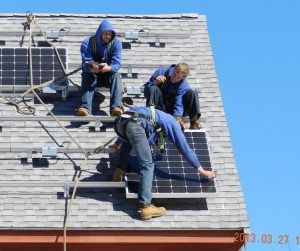As we outlined in an earlier issue/blog, we divide each solar project into five stages; the Sales Stage, then Engineering, Operations, Installation and finally Close Out. In this series we went out of order, so in Part 1 we covered Close Out (the very end) and last month we covered Engineering and Operations. We could have taken them all in order of course, but since Engineering, Operations, and Close Out are the least “visible” to our customers we decided to cover those three first. So in this issue we’ll cover what you’ll see the most of as a customer; Sales stage and Solar Installation stage.

Notice that our crews all use proper fall gear. It is another source of “peace of mind” for our customers.
The Sales Stage (aka The Paper Chase)
We technically define the Sales Stage as starting after you say yes, “I’d like to go ahead with the project.” Yes, you could say the sales stage starts as soon as you call us or fill out one of our “Free Assessment” or “Get Started” forms because that is the moment we start assessing your home or business for solar. But for the sake of this article, we’ll look at it from our Operations point of view and that, as noted, starts when you ask for an agreement. So beyond the agreement, what else is there to do?
Well, beyond an agreement, we need to create a complete statement of work for you (specifying what you are buying and where it is going), paperwork for your utility, paperwork for any incentives you may qualify for, paperwork for your town (for things like permits etc), and even a request for some information for our marketing effort. And of course, an invoice for your initial deposit.
It’s a lot to review and read, but your Solar Consultant and our Operations staff will put all of that together for you and send it to you via a system called “SignNow”. Basically, this allows you to review everything on-line and sign with a simple click. You can even do it on your phone. That said, if you absolutely want to do the paperwork on paper, we can do that too. In most cases, we can do this stage in a few days – but sometimes it is a lot longer depending on the complexity or type of your project (particularly if your project is a large commercial installation or ground mount).
Solar Installation Stage (Excitement!)
As noted, the Solar Installation Stage comes after Engineering and Operations. I call it exciting because, well, it’s pretty much the stage everyone is focused on. In fact, I’d say that most people think of it as the only really important part of the process. In short, it’s not unreasonable to think: “We sign, then you install. Isn’t it that simple?”
In short, no, it isn’t. As hopefully this series has outlined, there is a whole lot to the process that is (fortunately or unfortunately) hidden. There is a long list of things that have to be done before your system goes in as well as afterward. That’s because there are so many different “players” involved. The utility, the incentive programs, your town, your inspector, engineering/safety requirements; the list gets long in a hurry. Since solar panels look so simple once they are installed it is easy to rush to the thought, “Hey, you just plug them in right?” But no, that is not the case. While it isn’t the same in many ways as say a whole new house addition, it could be considered that way for many reasons. In fact, we could argue the addition is easier since your utility at least wouldn’t be involved.
But it’s still fair to say that the Installation Stage is the central focus. It starts when we schedule your project to a specific date once everything before it has been completed. For some homes, the installation happens in just a day or two. Others it could take a week (and commercial, perhaps a lot more). Ground mounts are particularly complex and of course frozen or muddy earth will delay instalaltions. Further, we have found that projects can often go faster if we divide up work between rack installation and electrical work. How your particular project will play out may differ, but we’ll let you know beforehand. And each installation crew will start by walking you through the process and going over all final installation questions. Our crews (and a select group of sub-contractors) are consistently our strongest customer pleasers. In short, they do excellent work.
In Summary
In summary, installing solar is not terribly complex, but there are many different forces that drive requirements and necessary processes. Furthermore, a solar system can in fact be quite dangerous. We’ve all heard reports on fires on Walmart buildings for example. We believe those issues are primarily driven by shoddy work and a relentless drive to cut costs which can often lead to cutting corners. Thus we believe that taking a bit more time to plan appropriately and install to not just the letter of the law (and building code), but to an even higher standard is extremely important. Such an approach is paramount to creating a safe, long lived systems. After all, you’re not buying a system to last for a few years. We’re looking to have it last decades. Yes, the panels are warrantied for 25 years, but the system should in fact last much longer if you so wish. The work that goes into installing it – before, during, and after the actual installation effort – is absolutely critical.
If you like this article, you may also like:




